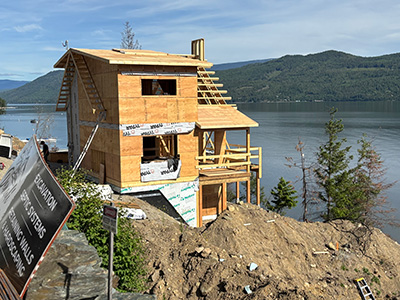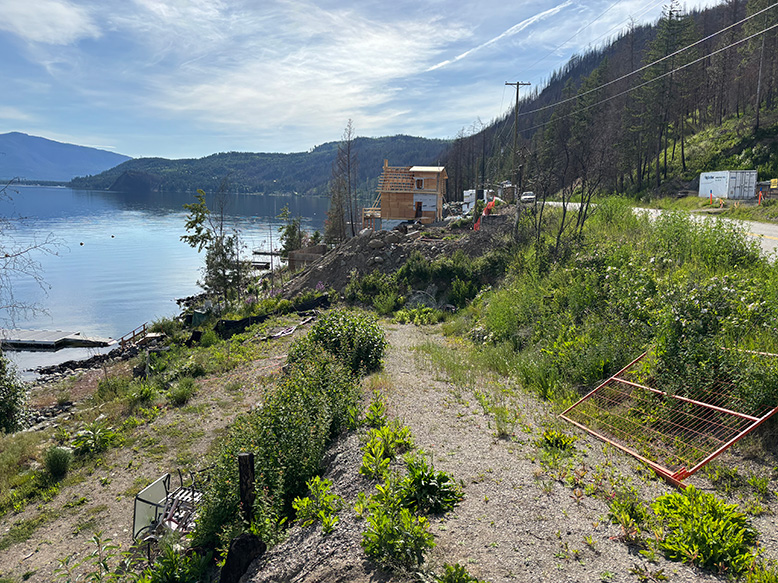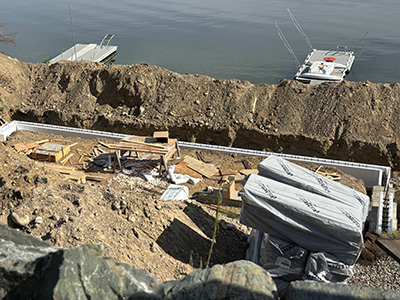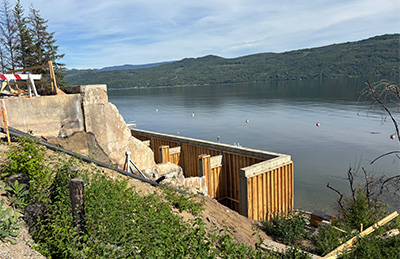Rebuilding in Celista and Scotch Creek after the 2023 wildfire is in full swing.
As of May 24th, there have been 58 building permits issued for wildfire recovery. Not surprisingly, the biggest challenges have been the waterfront rebuilding in Celista to meet both geotechnical concerns and Riparian Area Protection Regulations (RAPR). Of the 29 waterfront homes that were destroyed, only one was able to meet the 15 metre Streamside Protection and Enhancement Area (SPEA) setback requirement.
The province deserves a lot of credit for stepping up and helping homeowners on a path towards rebuilding. It was clear from the onset that RAPR setbacks were going to be a problem. The province responded with a new initiative, the Riparian Recovery – 2023 Wildfire Rebuilding Direction. The principles were:
- The province retained a Qualified Environmental Professional (QEP) who established allowable footprints and siting for replacement houses.
- Essentially, the size of pre-existing house footprints was grandfathered regardless of whether permanent foundations existed or not. Accessory buildings in the SPEA received no protection.
- The province also used their QEP to specify a planting prescription in the SPEA and created a Restoration Fund that homeowners can apply to cover their costs.
Of the 29 waterfront homes destroyed, the province has approved the location and footprint of 22. With the one lot that could meet the 15-metre setback, that leaves 6 owners who haven’t signed up with the new direction. The program expires at the end of 2025 so those owners need to sign up so they don’t miss the opportunity to rebuild.
Getting provincial RAPR approval is only one step in the rebuilding process. While Celista doesn’t have a zoning bylaw, there is an Official Community Plan that requires development permits to address both environmental and public safety concerns and a building bylaw. This is where the heavy lifting starts for the CSRD.
In the case of rebuilding on the waterfront in Celista, there are 3 development permits required; Riparian (addressed through the RAPR program), 100 metre Lake (covers new septic installations and run-off), and Steep Slopes (to protect life and safety from rock falls and slope failures). The latter 2 require a professional report that needs to reviewed by staff.
These development permits are managed by the CSRD planning department. The 3 separate permits are combined into one for the following statistics. As of May 24th, they have issued 46 Development Permits, 14 of which are for waterfront properties. 2 more are under review, of which one is waterfront.
The building bylaw outlines the requirements to get a building permit. Design drawings are submitted and reviewed by staff to ensure compliance with the BC Building Code.
As of May 24th, the building department has issued 58 building permits for wildfire recovery, 7 of which are waterfront. There are also 11 more fire rebuilds undergoing technical reviews and of these, 6 are waterfront properties.
Shuswap Lake water quality is also being protected in the rebuilding process. The 100 metre Lake development permit requires a report prepared by a groundwater hydrologist to address any concerns over new septic systems and storm run-off, The building permit process also requires that a new septic system is designed and built according to the Sewerage system Regulation. Although some of the waterfront houses that were destroyed in the 2023 wildfire had proper systems, there were still some still that relied on old undersized drainage fields or dry wells. All of those will now be upgraded with drainage fields installed on the upland side of the road away from the lake.
It has been really exciting to see houses and businesses being rebuilt and the communities of Scotch Creek and Celista being restored. This has been a massive undertaking for CSRD and provincial staff who have accomplished this while also dealing with normal workloads. It has also been a team effort to get homes finished. It is important to recognize how well the building professionals have responded to the demand. This includes building contractors, suppliers, house designers, professional engineers, surveyors, biologists, septic contractors, and landscapers. It has been a bumpy road to get where we are today but the results speak for themselves.
This experience should bring some comfort to other waterfront owners whose houses don’t meet current setback standards under the normal RAPR program.




